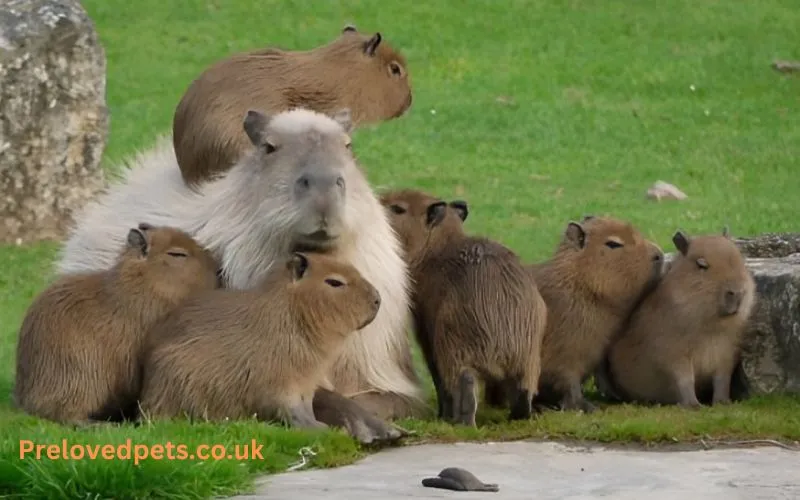Capybaras, the largest rodents in the world, have become increasingly popular as exotic pets. Native to South America, these gentle giants are known for their sociable nature and unique appearance. However, keeping a capybara as a pet in the UK comes with its own set of challenges and responsibilities. This comprehensive guide will delve into everything you need to know about owning a capybara in the UK, from legal considerations to their care requirements.
Introduction to Capybaras
Capybaras (Hydrochoerus hydrochaeris) are semi-aquatic mammals native to the wetlands and savannas of South America. They are closely related to guinea pigs and rock cavies. Adult capybaras typically weigh between 35 and 66 kg (77 and 146 lbs) and can grow up to 1.2 meters (4 feet) in length. Known for their docile temperament and social behavior, capybaras live in groups and spend a lot of time in water.
Capybaras are fascinating animals with several unique characteristics. They have webbed feet that aid in swimming, and their eyes, ears, and nostrils are positioned on top of their heads, allowing them to stay mostly submerged while keeping a lookout for predators. They have a lifespan of 8 to 10 years in the wild, but with proper care, they can live up to 12 years in captivity. These animals are crepuscular, meaning they are most active during dawn and dusk. Their social nature is evident in their communication, which includes a range of vocalizations like purring, barking, and whistling.
Legal Considerations in the UK

Before deciding to keep a capybara as a pet, it is crucial to understand the legal requirements in the UK. Capybaras are classified as exotic animals and may require a license under the Dangerous Wild Animals Act 1976. The requirements for obtaining a license vary by local council, so it’s essential to check with your local authority. The application process typically involves an inspection of the proposed habitat by a qualified inspector to ensure it meets all welfare standards. There may be fees associated with obtaining and renewing the license, which can vary depending on the local council.
The UK has strict regulations regarding the welfare of exotic pets, and you must ensure that the housing and care you provide meet the specific needs of a capybara. This includes ample space, access to water, and appropriate socialization. Under the Animal Welfare Act 2006, pet owners are responsible for ensuring that the welfare needs of their pets are met, including providing a suitable environment, diet, behavior, companionship, and protection from pain, suffering, injury, and disease.
If you plan to import a capybara, you must comply with the UK’s import regulations, which include health checks and quarantine measures. Capybaras are listed under the Convention on International Trade in Endangered Species of Wild Fauna and Flora (CITES), which regulates their trade to ensure it does not threaten their survival. Breeding capybaras also requires adherence to specific guidelines to ensure the well-being of both the parents and the offspring.
Capybara Habitat and Housing Requirements
Capybaras are highly social animals that thrive in environments that mimic their natural habitat. They need a lot of space to roam and graze. An outdoor enclosure should be at least 100 square meters per capybara, with secure fencing to prevent escape and protect them from predators. The enclosure should include areas for foraging, resting, and swimming. Ensure the fencing is at least 1.5 meters high and extends below ground to prevent burrowing out. Climate considerations are crucial, as capybaras prefer warm climates. If you live in a colder region, you may need to provide heated shelters during winter months.
Being semi-aquatic, capybaras require access to water for swimming and soaking. A large pond or a pool is essential, and the water should be clean and regularly maintained to prevent infections. Installing a filtration system can help maintain water quality. Provide a shelter within the enclosure where capybaras can rest and seek protection from extreme weather. The shelter should be dry, warm, and well-ventilated, with straw or hay as bedding material to keep it comfortable.
Capybaras are intelligent animals that need mental and physical stimulation. Providing various enrichment items such as chew toys, logs, and tunnels is important. You can also scatter food around the enclosure to encourage natural foraging behavior.
Diet and Nutrition
A proper diet is crucial for the health and well-being of capybaras. Their diet should closely resemble what they would eat in the wild. Capybaras are herbivores that primarily eat grasses. In captivity, provide a mix of fresh grass, hay, and specially formulated rodent pellets. Timothy hay is a good staple, but you can also offer alfalfa hay in moderation. Supplement their diet with a variety of fruits and vegetables such as carrots, apples, sweet potatoes, and leafy greens. Safe vegetables include cucumbers, zucchini, and bell peppers, while you should avoid toxic foods like avocado and certain nightshades.
Capybaras need a regular supply of vitamin C, as they cannot produce it themselves. Ensure their diet includes vitamin C-rich foods or supplements. Vitamin C tablets or drops can be added to their diet if natural sources are insufficient. Fresh, clean water should always be available. Although they get a lot of their hydration from their food, they still need access to drinking water. Use large, stable water bowls or automatic water dispensers to ensure they have a constant supply.
Social Needs and Interaction
Capybaras are social creatures that thrive in groups. Keeping a single capybara can lead to loneliness and behavioral issues. It is highly recommended to keep capybaras in pairs or small groups. If you can’t keep multiple capybaras, ensure they have plenty of interaction with humans and other animals. Understanding the social hierarchy within capybara groups is important to monitor interactions and prevent bullying or aggression.
Spend time interacting with your capybara daily. They enjoy gentle petting and can form strong bonds with their caregivers. Introduce capybaras to new people and environments gradually to build their confidence. Capybaras can get along well with other pets, especially dogs and cats, if introduced properly. Supervised interactions are crucial to ensure safety and compatibility. Conduct initial meetings in neutral spaces and watch for signs of stress or aggression.
Health Care and Veterinary Needs
Keeping capybaras healthy requires regular veterinary care and attention to their unique health needs. Find a veterinarian experienced with exotic animals, particularly rodents. Regular health check-ups are essential to monitor their condition and prevent diseases. Ensure you have access to emergency veterinary services familiar with capybaras. Capybaras are prone to dental issues, skin infections, and gastrointestinal problems. Regularly check their teeth, skin, and overall behavior for signs of illness. Capybaras’ teeth grow continuously, so provide chew toys and fibrous foods to help wear down their teeth naturally. Regularly check for external parasites like ticks and fleas, and consult your vet for appropriate treatments.
While capybaras don’t require vaccinations like dogs or cats, it’s important to discuss preventive measures for parasites with your vet. Regular fecal exams can help detect and treat internal parasites. Capybaras do not require extensive grooming, but regular checks and cleaning of their ears and fur are necessary to prevent infections. Occasionally bathe your capybara to keep their fur clean, especially if they do not have access to natural bodies of water.
Challenges of Keeping Capybaras as Pets
While capybaras can make delightful pets, there are significant challenges to consider. Capybaras need a lot of space, which can be difficult to provide in a typical household setting. Urban settings may not offer enough outdoor space, and the local environment might not be suitable for a capybara’s needs. The cost of setting up a suitable habitat, ongoing care, and veterinary expenses can be high. Initial setup costs include building or modifying an enclosure, purchasing equipment, and obtaining a license. Ongoing expenses include food, veterinary care, and maintenance.
Ensuring compliance with legal requirements and providing ethical care are ongoing responsibilities. Reflect on the ethical implications of keeping an exotic animal as a pet and whether you can meet all their needs. Meeting their social and behavioral needs requires a substantial time commitment. Be prepared to spend several hours a day interacting with and caring for your capybara. Capybaras can carry diseases that may be transmissible to humans or other pets. Proper hygiene and regular health checks are essential. Be aware of diseases that can be transmitted from capybaras to humans, such as leptospirosis.
Conclusion
Owning a capybara in the UK is a rewarding but challenging endeavor. These unique creatures require specific care, ample space, and social interaction to thrive. Before committing to a capybara as a pet, it is essential to thoroughly research and prepare for their needs. By understanding and meeting their requirements, you can ensure a happy and healthy life for your capybara, making it a cherished member of your household.
Keeping exotic pets like capybaras is not for everyone. It requires dedication, resources, and a deep commitment to animal welfare. If you are prepared for the responsibility, a capybara can bring joy and unique experiences to your life. Always prioritize their well-being and strive to provide an environment that meets their natural and social needs.




